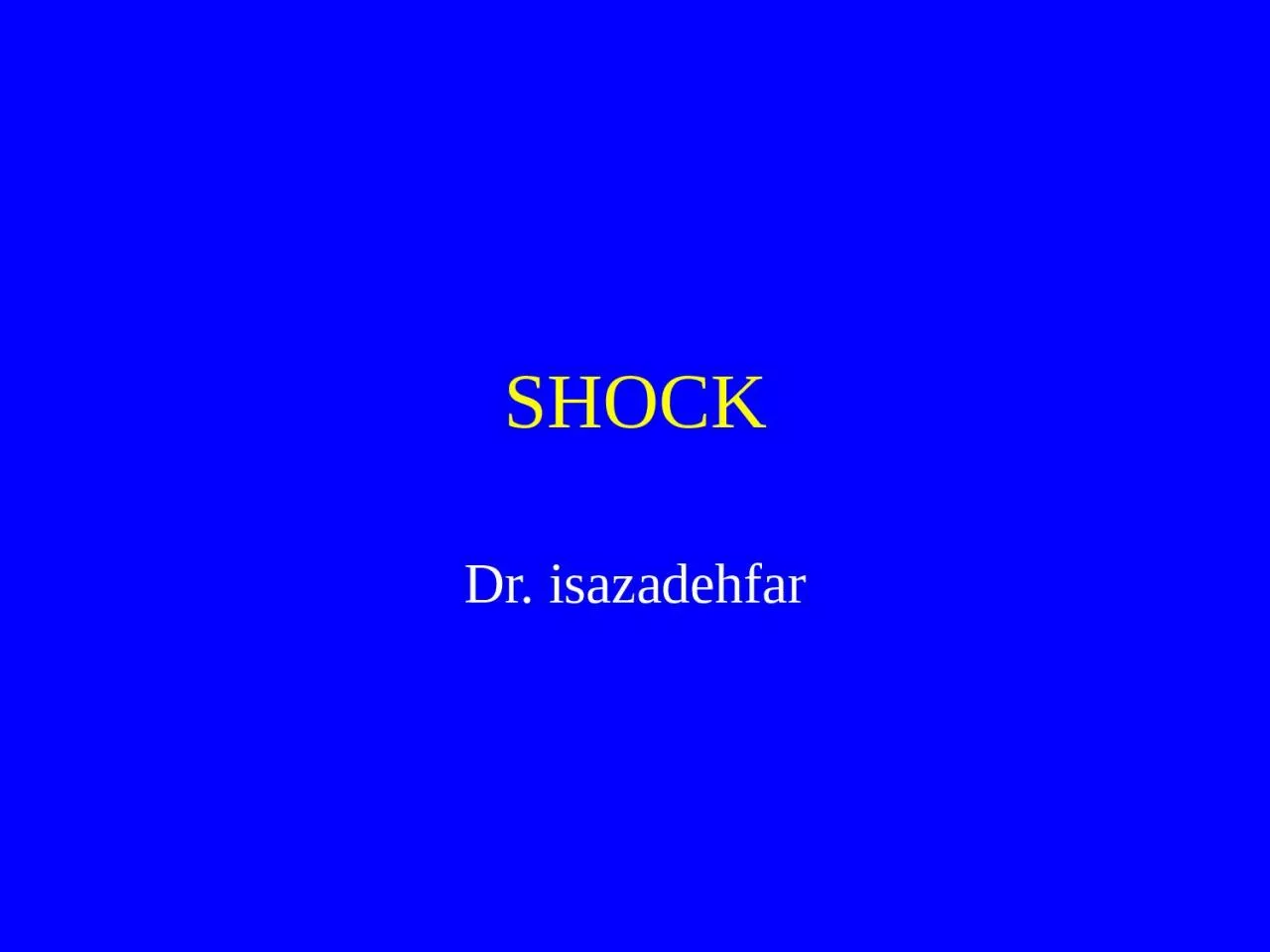

Profound hemodyamic and metabolic disturbance characterized by failure of the circulatory system to maintain adequate perfusion of vital organs Types of Shock Cardiogenic intracardiac vs extracardiac ID: 1033138
Download Presentation The PPT/PDF document "SHOCK Dr. isazadehfar DEFINITION" is the property of its rightful owner. Permission is granted to download and print the materials on this web site for personal, non-commercial use only, and to display it on your personal computer provided you do not modify the materials and that you retain all copyright notices contained in the materials. By downloading content from our website, you accept the terms of this agreement.
1. SHOCKDr. isazadehfar
2. DEFINITIONProfound hemodyamic and metabolic disturbance characterized by failure of the circulatory system to maintain adequate perfusion of vital organs
3. Types of ShockCardiogenic (intracardiac vs extracardiac)HypovolemicDistributivesepsis****neurogenic (spinal shock)adrenal insufficiencyanaphylaxis
4.
5.
6.
7. Cardiogenic Shock, intracardiacMyocardial Injury or Obstruction to FlowArrythymias valvular lesionsAMISevere CHFVSDHypertrophic Cardiomyopathy
8.
9. Presentation of Cardiogenic ShockPulmonary EdemaJVDhypotensiveweak pulsesoliguria
10. Cardiogenic Shock, extracardiac(Obstructive)Pulmonary EmbolismCardiac TamponadeTension PneumothoraxPresentation will be according to underlying disease process.
11.
12. Hypovolemic ShockReduced circulating blood volume with secondary decreased cardiac outputAcute hemorrhageVomiting/DiarrheaDehydrationBurnsPeritonitis/Pancreatitis
13.
14.
15. Presentation of Hypovolemic ShockHypotensiveflat neck veinsclear lungscool, cyanotic extremitiesevidence of bleeding?Anticoagulant usetrauma, bruisingoliguria
16.
17. Distributive ShockPeripheral Vasodilatation secondary to disruption of cellular metabolism by the effects of inflammatory mediators. Gram negative or other overwhelming infection.Results in decreased Peripheral Vascular Resistance.
18.
19.
20. Distributive Shock: PresentationFebrileTachycardicClear lungs, evidence of pneumoniaWarm extremitiesFlat neck veinsOliguria
21. Diagnosing Shock Response to fluidsEcho/EKGCXREvidence of infectionSwan-Ganz Catheter?
22. Swan-Ganz CatheterUtilized to differentiate types of shock and assist in treatment response.Probably overused by physicians. Studies documenting increased mortality in patients with catheters versus no catheters, although somewhat swayed by selection bias.
23. Swan-Ganz Catheter
24.
25. Swan-Ganz Interpretation
26. ManagementCorrect underlying disorder if possible and then direct efforts at increasing the blood pressure to increase oxygen delivery to the tissues.Maintain a mean arterial pressure of 60 (1/3 systolic + 2/3 diastolic)Keep O2 sats >92%, intubate if neccesary
27. Correction of hypotension Normal Saline should be administered anytime a patient is hypotensive. If hypotension exists give more NS. *** If possible give blood as it replaces colloid. Vasopressors Inotropic agents for cardiogenic shock Intra-aortic Balloon Pump for cardiogenic
28. Autonomic Drugs in Shock
29. Management of Cardiogenic ShockAttempt to correct problem and increase cardiac output by diuresing and providing inotropic support. IABP is utilized if medical therapy is ineffective. Catheterization if ongoing ischemiaCardiogenic shock is the exception to the rule that NS is always given for hypotension NS will exacerbate cardiac shock.
30. Intra-Aortic Balloon Pump
31. Management of Septic ShockEarly goal directed therapyIdentification of source of infectionBroad Spectrum AntibioticsIV fluids VasopressorsSteroids ??Bicarbonate if pH < 7.1
32. Management of Hypovolemic ShockCorrect bleeding abnormalityIf PT or PTT elevated then FFPAggressive Fluid replacement with 2 large bore IV’s or central line.Pressors are last line, but commonly required.
33. Addison’s DiseaseDeficiency of cortisol and aldosterone production in the adrenal glandsThis is suspected when patient is non-responsive to fluids and antibiotics.Electrolytes may reveal hyponatremia and hyperkalemiaHydrocortisone 100 mg IV immediately then taper appropriately